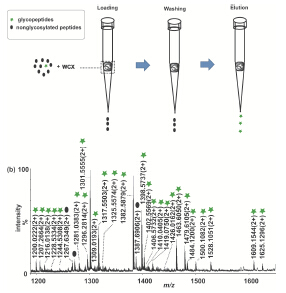

A Novel Glycopeptides Enrichment Method Using Weak Cation Exchange Chromatography Material under Hydrophilic Interaction Liquid Chromatography Mode
Received date: 2015-05-29
Online published: 2015-11-19
Supported by
Project supported by the National Natural Science Foundation of China (Nos. 81171486, 21475129) and Distinguished Professor of Liaoning Province.
Protein glycosylation is a vital bio-process in organisms. Selective enrichment of glycopeptides before mass spectrometry (MS) plays an important role in proteomics owing to the low glycopeptides proportion and the suppression effect of the non-glycosylated peptides. There are several methods used for the enrichment of glycopeptides with their own merits and drawbacks. Among them, hydrophilic interaction liquid chromatography (HILIC) is increasingly applied to glycopeptides enrichment with its promising prospects. In this paper, a new strategy for the enrichment of glycopeptides using a commercial weak cation exchange chromatography (WCX) material under HILIC mode was developed. The influence of concentration of acetonitrile (ACN) and pH value on the retention of tryptic fetuin digests on WCX were studied. Results indicated that non-glycosylated peptides on WCX micro-column were eluted prior to glycopeptides when the concentration of ACN gradually decreased. Furthermore, the hydropathy index of peptides contained in glycopeptides also affected the retention. The bigger the index was, the later the plycopeptides eluted. Meanwhile, the glycopeptides were retained more strongly at lower pH than higher pH. When using WCX to enrich glycopeptides, it was found that not only sialic acid containing glycopeptides but also neutral ones could be selectively enriched. In the enrichment of tryptic IgG digests, 25 glycopeptides were found by WCX while only 1 glycopeptides were found before enrichment. And when the tryptic fetuin digests were enriched by WCX, the glycopeptides numbers detected by MS increased to 39, in contrast to only 2 before enrichment. What's more, WCX can enrich glycopeptides even under relatively complex surrounding. 23 IgG glycopeptides and 26 fetuin glycopeptides could be enriched by WCX when they were respectively mixed with bovine serum albumin (BSA) at a molar ratio of 1:5. The results indicated that glycopeptides could be selectively enriched by WCX under HILIC mode. This is a new glycopeptides enrichment method, which expands the application of WCX and enriches the variety of HILIC material.

Li Xianqin , Yu Dongping , Feng Xiaomin , Guo Zhimou , Li Xiuling , Zou Lijuan , Liang Xinmiao . A Novel Glycopeptides Enrichment Method Using Weak Cation Exchange Chromatography Material under Hydrophilic Interaction Liquid Chromatography Mode[J]. Acta Chimica Sinica, 2015 , 73(10) : 1074 -1079 . DOI: 10.6023/A15050370
[1] Apweiler, R.; Hermjakob, H.; Sharon, N. Biochim. Biophys. Acta 1999, 1473, 4.
[2] Kazuaki, O.; Marth, J. D. Cell 2006, 19, 855.
[3] Chandler, K.; Goldman, R. Mol. Cell. Proteomics 2013, 12(4), 836.
[4] Pinho, S. S.; Carvalho, S.; Marcos-Pinto, R.; Magalhaes, A.; Oliveira, C.; Gu, J.; Dinis-Ribeiro, M.; Carneiro, F.; Seruca, R.; Reis, C. A. Trends Mol. Med. 2013, 19(11), 664.
[5] Padler-Karavani, V. Cancer Lett. 2014, 352, 102.
[6] Kawakami, S.; Hashida, M. J. Controlled Release 2014, 190, 542.
[7] Yu, L.; Li, X. L.; Guo, Z. M.; Zhang, X. L.; Liang, X. M. Chem. Eur. J. 2009, 15, 46.
[8] Calvano, C. D.; Zamboninb, C. G.; Jensen, O. N. J. Proteomics 2008, 71, 304.
[9] Kullolli, M.; Hancock, W. S.; Hincapie, M. Anal. Chem. 2010, 82, 115.
[10] Shi, Z. M.; Fan, C.; Huang, J. J.; Bai, H. H.; Qin, W. J.; Cai, Y.; Qian, X. H. Chin. J. Chromatogr. 2015, 33(2), 116 (时照梅, 范超, 黄俊杰, 白海红, 秦伟捷, 蔡耘, 钱小红, 色谱, 2015, 33, 116.)
[11] Liu, L. T.; Zhang, Y.; Jiao, J.; Yang, P. Y; Lu, H. J. Acta Chim. Sinica 2013, 71, 535. (刘丽婷, 张莹, 焦竞, 杨芃原, 陆豪杰, 化学学报, 2013, 71, 535.)
[12] Liu, L. T.; Zhang, Y.; Zhang, L.; Yan, G. Q.; Yao, J.; Yang, P. Y.; Lu, H. J. Anal. Chim. Acta 2012, 753, 64.
[13] Wang, Y. L.; Liu, M. B.; Xie, L. Q.; Fang, C. Y.; Xiong, H. M.; Lu, H. J. Anal. Chem. 2014, 86, 2057.
[14] Zhao, X.; Jiang, W. H ; Yu, L.; Zou, L. J.; Li, X. L.; Liang, X. M. Acta Chim. Sinica 2013, 71, 343. (赵旭, 姜武辉, 于龙, 邹丽娟, 李秀玲, 梁鑫淼, 化学学报, 2013, 71, 343.)
[15] Li, X. L.; Shen, G. B.; Zhang, F. F.; Yang, B. C; Liang, X. M. J. Chromatogr. B 2013, 941, 45.
[16] Zhang, Y.; Go, E. P.; Desaire, H. Anal. Chem. 2008, 80, 3144.
[17] Takegawa, Y.; Deguchi, K.; Ito, H.; Keira, T.; Nakagawa, H.; Nishimura, S. I. J. Sep. Sci. 2006, 29, 2533.
[18] Liang, X. M. Chin. J. Chromatogr. 2011, 29(3), 191 (梁鑫淼, 色谱, 2011, 29(3), 191.)
[19] Buszewski, B.; Noga, S. Anal. Bioanal. Chem. 2012, 402, 23.
[20] Selman, M. H. J.; McDonnell, L. A.; Palmblad, M.; Renee Ruhaak, L.; Deelder, A. M.; Wuhrer, M. Anal. Chem. 2010, 82, 1073.
/
| 〈 |
|
〉 |